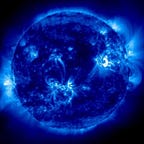THE TWO ASSUMPTIONS GRAVITY MODEL :
A probably wrong Occam’s Razor Optimized Gravity Conjecture (2.0)
January 25, 2021
Avraam J. Dectis
A. Preface
The most widely accepted explanation of gravity relies upon a set of assumptions that are not fully accepted by the scientific community. Conservation of momentum is supposed to explain accelerating toward the center of a large mass. Curved space is supposed to explain orbits. Dark matter is an assumption proposed to explain why galaxies spin faster than they should, under the above explanation of gravity, as well as other phenomena. Dark Energy is an assumption proposed to explain why space is expanding.
There may be an excess of assumptions.
Occam’s Razor, the widely accepted problem-solving principle, suggests that when equally explanatory solutions are offered, the simplest should be selected — at least in terms of experimental attention.
This is an attempt to suggest a simpler explanation for the above phenomena: Gravity, dark matter, dark energy.
B. The Two Assumptions Model
If you can accept these two assumptions:
1) Spacetime is a fluidlike substance with streams, whirlpools and so forth. It is not a rigid grid that is bent by mass.
2) The formation of the quantum fabric of spacetime is inhibited by mass and, conversely, promoted by a massless environment, through the inhibition or promotion, respectively, of the entanglements that form spacetime.
Then you have:
1) An explanation for dark matter effects that do not require dark matter.
a. It is widely accepted that mass drags space. Therefore, the frame dragging of the rotating bodies in the galaxy create galaxy sized spacetime whirlpools, which allow a perceived velocity of rotating objects at the edge of the galaxy to seem to exceed gravitational pull, but in reality do not, for they are carried along by the surrounding space. It is one huge rotating frame.
b. The galactic gravitational lensing is also explained by the rotation, which is known to draw space in, producing a lens. Additionally, the gravity itself, as described below, also forms the lens.
c. The perception that dark matter separates from regular matter when galaxies collide is also explained by the fact that the collision of two rotating space frames will eject their mass as they collide.
d. Finally, the formation of huge cosmic filaments in the universe, which are attributed to dark matter, can be explained by chaotic mixing, which is a combination of chaos theory and fluid dynamics: Chaotic mixing — Wikipedia
2) An explanation for gravitational effects that do not require curved space ( or gravitons ).
a. As massive objects inhibit the continuing entanglements of spacetime, effectively destroying it, the surrounding spacetime replaces it, essentially drawn in, and that field effect presses all objects toward the center of the mass. It is a spacetime waterfall. The greater the mass, the greater the inhibition, the greater the waterfall and the greater the gravitational effect.
b. This also explains gravitational lensing. As the space is drawn toward the massive object, the photons going through it are also deflected a bit toward that mass. It is like trying to walk through a flowing stream. You will be drawn in the direction that it is going. Black holes at the event horizon are merely drawing in space at the speed of light.
3) An explanation for dark energy effects that do not require dark energy.
a. Intergalactic space, far from any mass, will have the entanglements that form space time in the state of least inhibition, thus creating more space.
b. It should be noted that we do not know what space is. It may be composed of particles that are neither matter nor energy and as small compared to an electron as an electron is small compared to a galaxy. ( We could call them Entangletons ). We are only aware of its attributes and should keep an open mind.
Of course, Occam’s Razor is not an arbiter of truth, but, it may sometimes point towards the path of truth.
This conjecture is probably wrong. It does not explain counter rotating galaxies whose counter rotating disks both require dark matter and which occupy the same space. A proper astrophysisist could likely point out a few more flaws. I am only posting it because of the charming elegance of the model and because I have yet to see the compelling evidence of its flaws, which most likely exist. FWIW, in other words.
